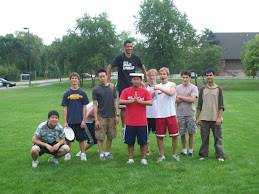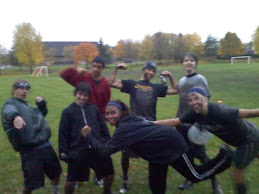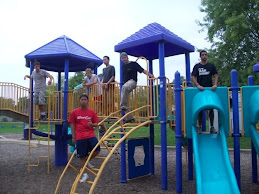INITIATE PLAY - Each point begins with both teams lining up on the front of their respective endzone line. The defense throws ("pulls") the disc to the offense.
SCORING - Each time the offense completes a pass in the defense's endzone, the offense scores a point. Play is initiated after each score.
MOVEMENT OF THE DISC - The disc may be advanced in any direction by completing a pass to a teammate. Players may not run with the disc. The person with the disc ("thrower") has ten seconds to throw the disc. The defender guarding the thrower ("marker") counts out the stall count
CHANGE OF POSSESSION - When a pass in not completed (e.g. out of bounds, drop, block, interception), the defense immediately takes possession of the disc and becomes the offense.
SUBSTITUTIONS - Players not in the game may replace players in the game after a score and during an injury timeout.
LENGTH OF GAME - Each half lasts for twenty (20) minutes of running time. The one overtime period lasts for five (5) minutes of running time. (If score is still tied after the one overtime, the score will be recorded as a tie game.) Halftime lasts for five (5) minutes.
TIME OUTS - Each team is permitted two (2) time-outs per half and one (1) time-out in overtime. Each time-out lasts up to one (1) minute. A time-out may be called by either team after a goal and before the ensuing accepted throw-off. During play, only a player who has established a pivot foot and who has possession of the disc can call a time-out.
OUT OF BOUNDS - Any area not on the playing field is out-of-bounds. The perimeter lines themselves are out-of-bounds. The thrower may pivot in- and out-of-bounds, providing that some part of the pivot foot contacts the playing field.
THE THROWER
- The thrower is the offensive player in possession of the disc, or the player who has just released the disc.
- The thrower must establish a pivot foot and may not change that pivot foot until the throw is released.
- The thrower has the right to pivot in any direction. However, once the marker has established a legal defensive position, the thrower may not pivot into the marker.
- If the disc is dropped by the thrower without defensive interference, it is considered an incomplete pass.
- The thrower may throw the disc in any way s/he wishes.
- A defensive player who establishes possession of the disc becomes the thrower, but may not throw the disc before s/he establishes a legal pivot foot. To do so is a traveling violation.
- Only one defensive player may guard the thrower at any one time; that player is the marker.
- The marker may not straddle (i.e., place his/her foot on either side of) the pivot foot of the thrower.
- There must be at least one disc's diameter between the upper bodies of the thrower and the marker at all times. It is the mutual responsibility of both players to respect each other's position and not encroach into this area once it is established.
- The marker cannot position his/her arms in such a manner as to restrict the thrower from pivoting.
- The receiver is any offensive player either in the act of catching the disc, or not in possession of the disc.
- After catching a pass, the receiver is only allowed the fewest number of steps required to come to a stop and establish a pivot foot.
- If the disc is caught simultaneously by offensive and defensive players, the offense retains possession.
- Force-Out Foul: If an airborne receiver catches the disc, and is contacted by a defensive player before landing, and that contact caused the receiver to land out-of-bounds instead of landing in-bounds, the receiver must either call him/herself out-of-bounds, or call a force-out foul on the defensive player. If this foul occurs in the end zone and it is uncontested, a goal is awarded.
SELF REFEREEING - Players are responsible for their own foul and line calls. Players resolve their own disputes.
FOULS - When a player initiates contact on another player a foul occurs. When a foul disrupts possession, the play resumes as if the possession was retained. If the player committing the foul disagrees with the foul call, the play is redone.
THROWING FOULS
- A throwing foul may be called when there is contact between the thrower and the marker.
- Contact occurring during the follow through (after the disc has been released) is not sufficient grounds for a foul, but should still be avoided whenever possible.
- When a foul is committed by a thrower or the marker, play stops and possession reverts back to the thrower after a check.
- If the thrower is fouled in the act of throwing and the pass is completed, the foul is automatically declined and play continues without interruption.
- If the marker is fouled in the act of throwing and the pass is not completed, play continues without interruption.
- A catching foul may be called when there is contact between opposing players in the process of attempting a catch, interception, or knock down. A certain amount of incidental contact during or immediately after the catching attempt is often unavoidable and is not a foul.
- If a player contacts an opponent before the disc arrives and thereby interferes with that opponent's attempt to make a play on the disc, that player has committed a foul.
- If a player's attempt to make a play on the disc causes significant impact with a legitimately positioned stationary opponent, before or after the disc arrives, it is considered "harmful endangerment" and is a foul.
- Dangerous, aggressive behavior or reckless disregard for the safety of fellow players is always a foul.
- If a catching foul occurs and is uncontested, the player fouled gains possession at the point of the infraction. If the call is disputed, the disc goes back to the thrower. If an uncontested foul (with the exception of a force-out foul) occurs in the end zone, the player fouled gains possession at the closest point on the goal line to the infraction.
- If there is ever a failure to come to an agreement over any call, the disc reverts back to the thrower after a check.
- If offsetting catching fouls are called by offensive and defensive players on the same play, the disc reverts back to the thrower after a check.
- A violation occurs when a player violates the rules in a manner which does not result in physical contact. (e.g. illegal guarding position by the marker, not establishing a pivot foot on the sideline after carrying the disc in from out-of-bounds, etc.)
- A violation may be called by any player who recognizes that a violation has occurred. The player must immediately call "violation" or the name of the specific violation loudly.
- The thrower must keep all or part of the pivot foot in contact with a single spot on the field. Should the thrower lose contact with that spot, the thrower has traveled.
- If the receiver obviously takes more steps than are required to stop after catching a pass, that player has traveled.
- If a receiver, after receiving a pass on the run, releases a pass after the third ground contact and before coming to a complete stop, that receiver has traveled.
- No defensive player may touch the disc while it is in possession of the thrower or receiver. If a defensive player does so, the player in possession calls "Strip."
- The player in possession then picks up the disc and play continues unhalted from the point where s/he regained possession.
- If a count was in progress as the disc was stripped, the count is halted, and when the player in possession regains possession, the count restarts at zero (0).
- A contested strip of the receiver is treated the same as a contested foul; an uncontested strip in the end zone is a goal.
PICKS
- No player may establish a position, or move in such a manner, so as to obstruct the movement of any player on the opposing team; to do so is a "pick".
- In the event of a pick, the obstructed player must immediately call "Pick" loudly; play stops and is resumed after a check.
- When the disc is in the air, players must play the disc, not the opponent.
- The Principle of Verticality: All players have the right to the space immediately above them. Thus, a player cannot prevent an opponent from making an attempt on a pass by placing his/her arms above an opponent. Should contact occur, the player restricting the vertical area is responsible.
- A player who jumped is entitled to land at the same spot without hindrance by opponents. S/he may also land at the another spot provided the landing spot was not already occupied at the time of take-off and that the direct path between the take-off and landing spot was not already occupied.



